Greer Lankton
TEXT BY TYLER AKERS
ARTWORK BY GREER LANKTON
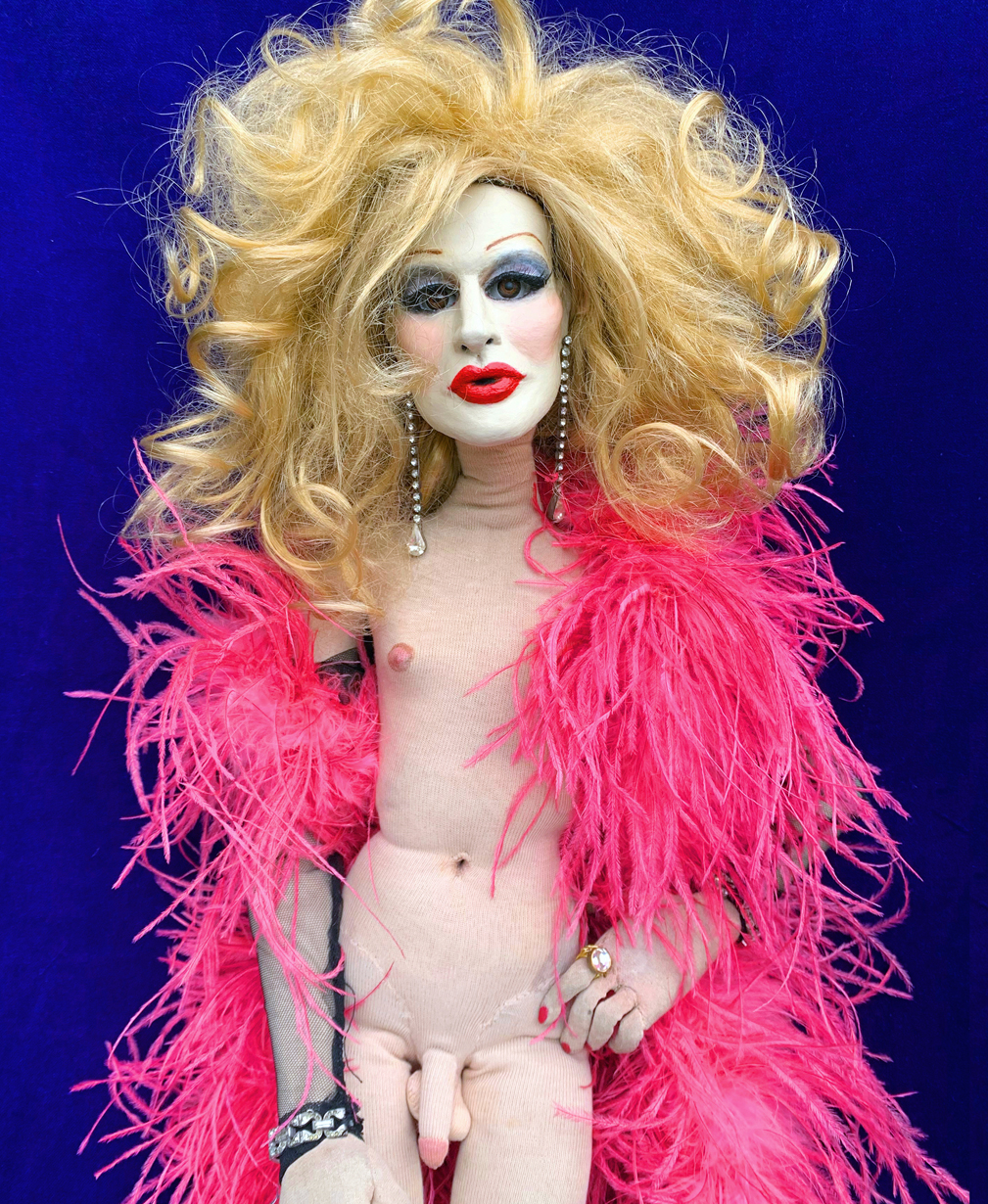
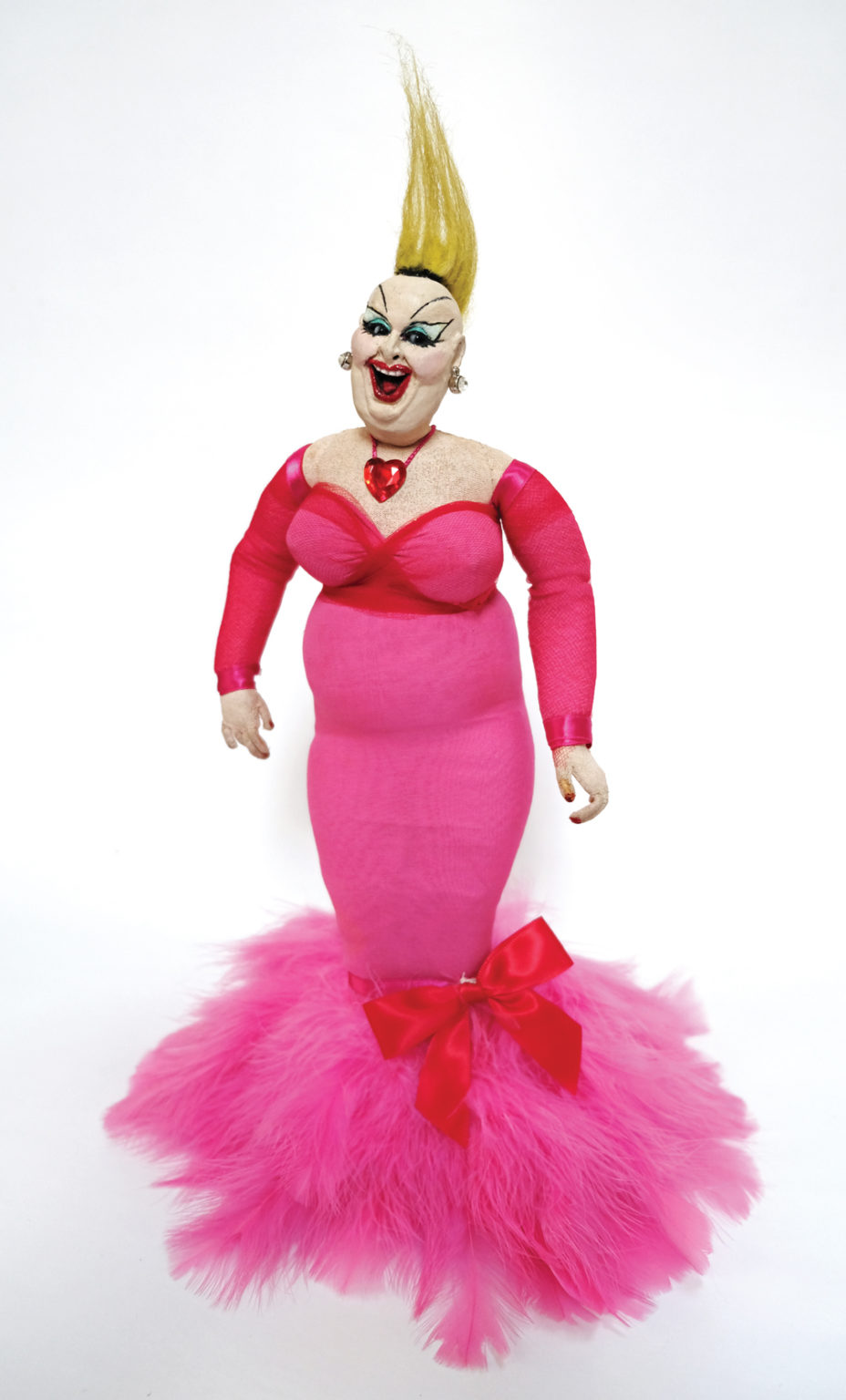
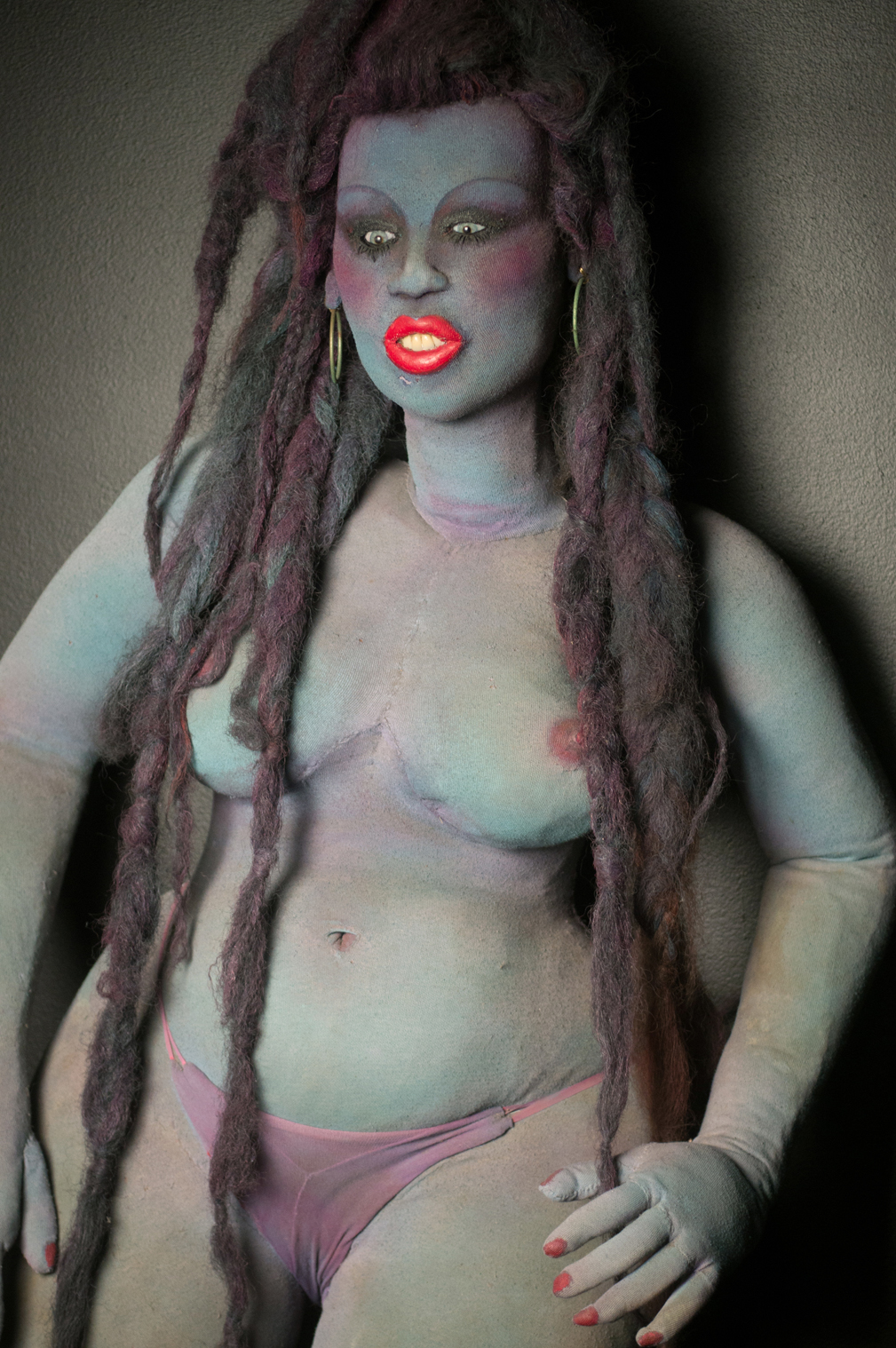


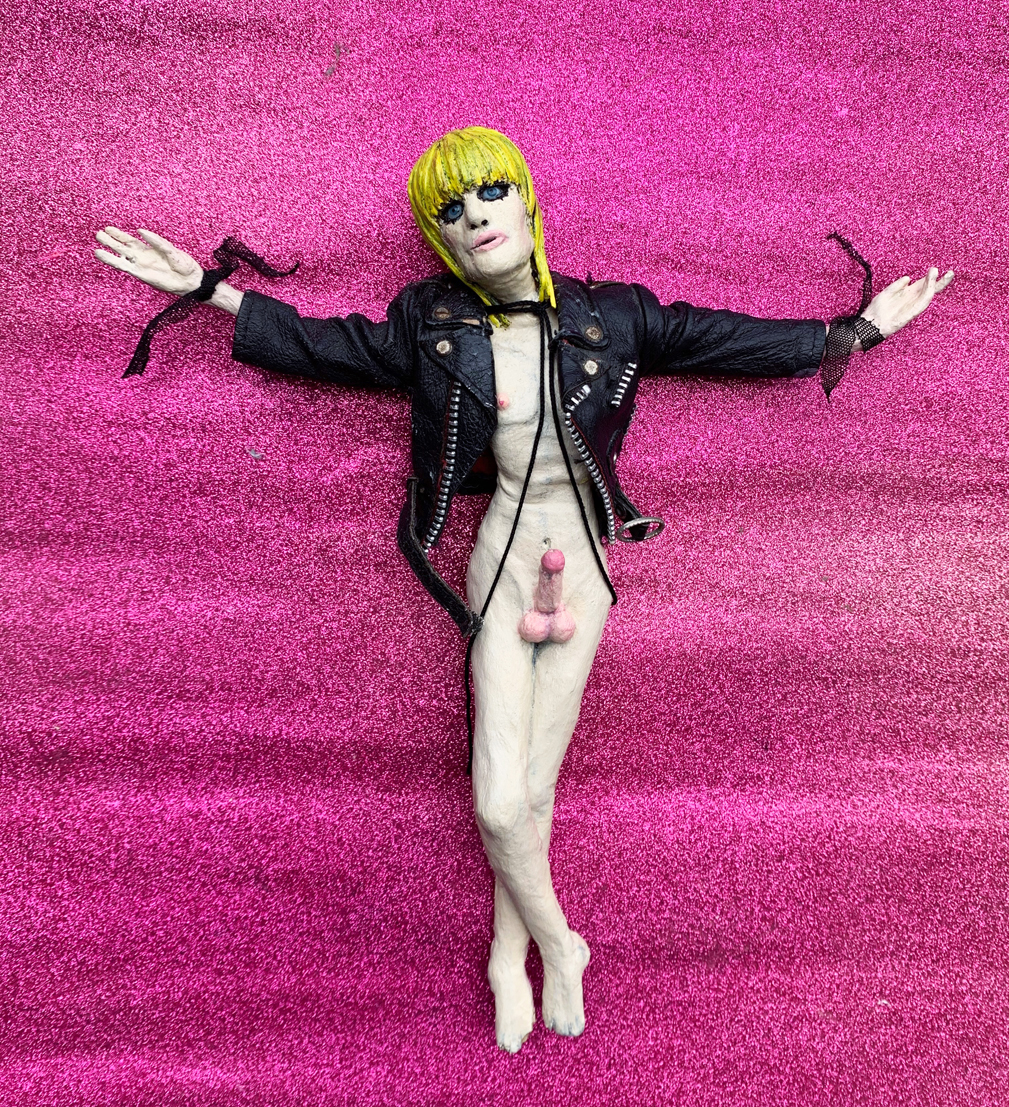
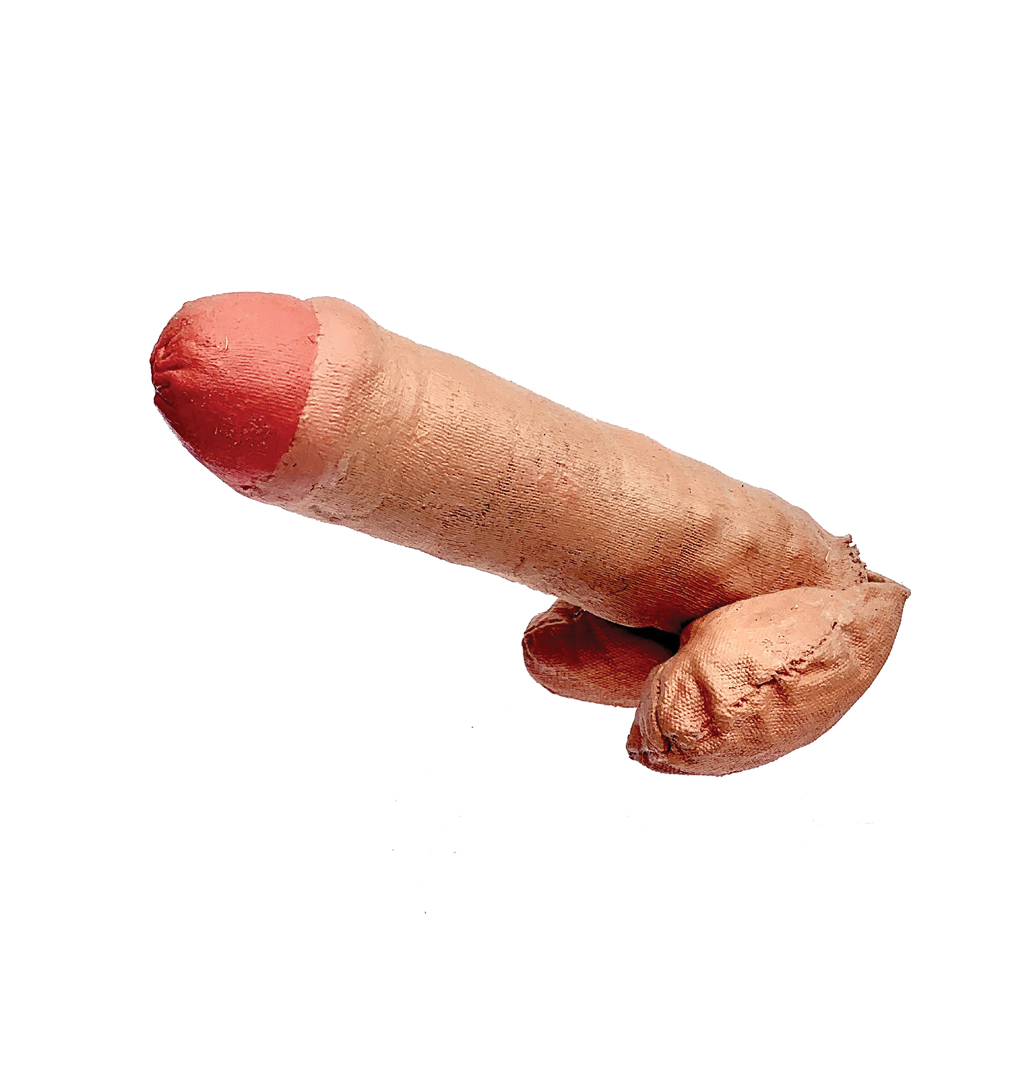

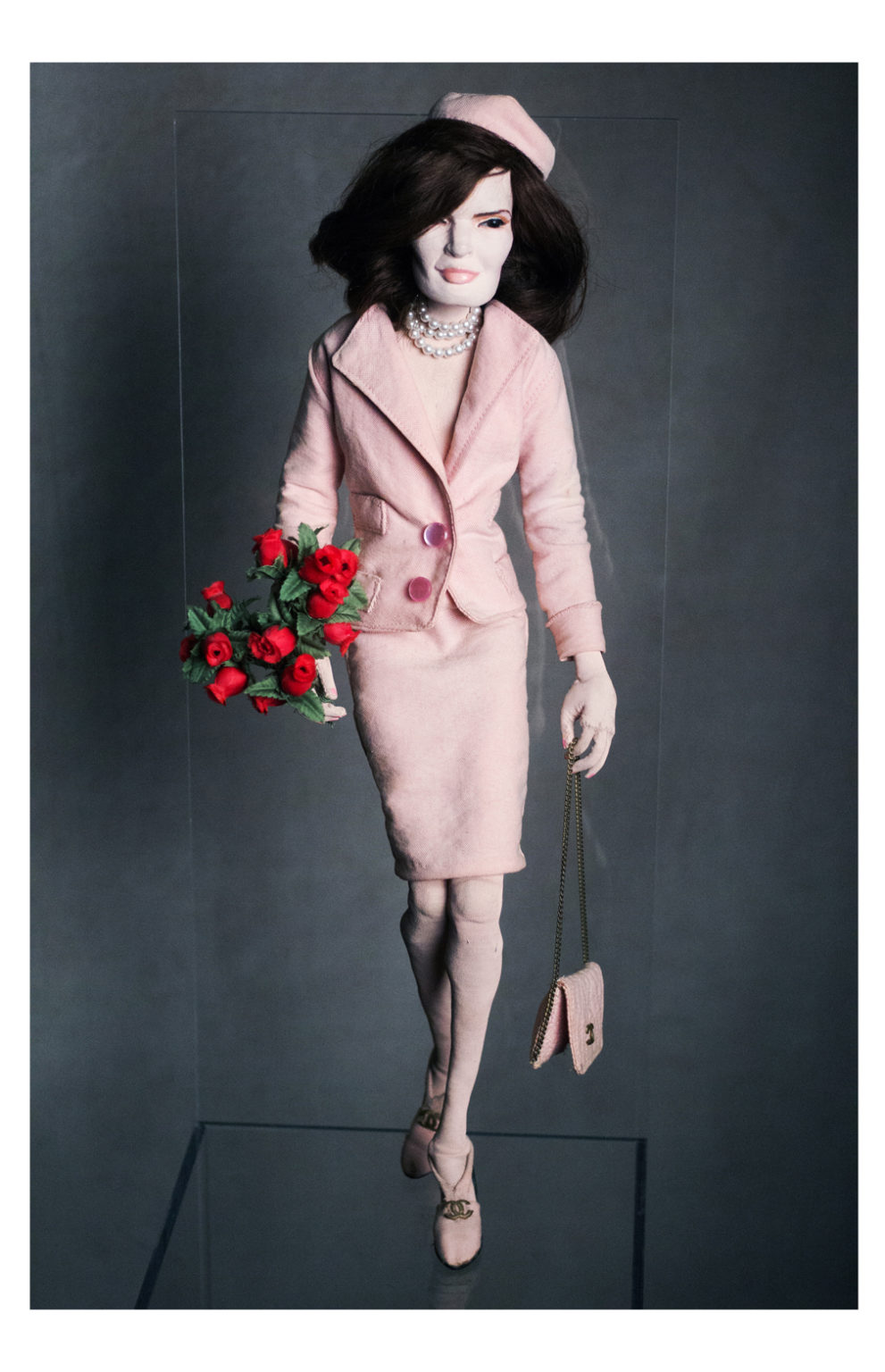
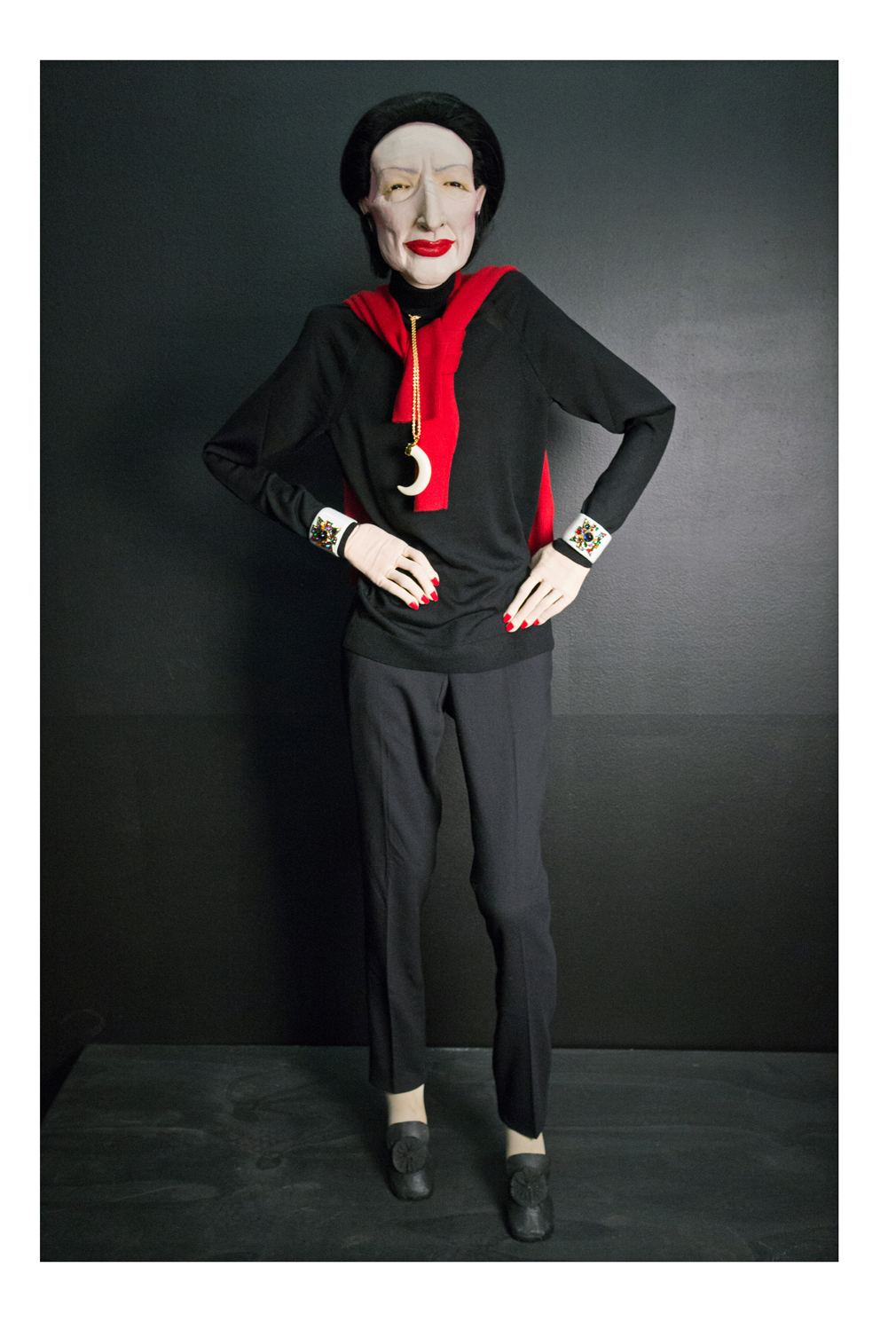

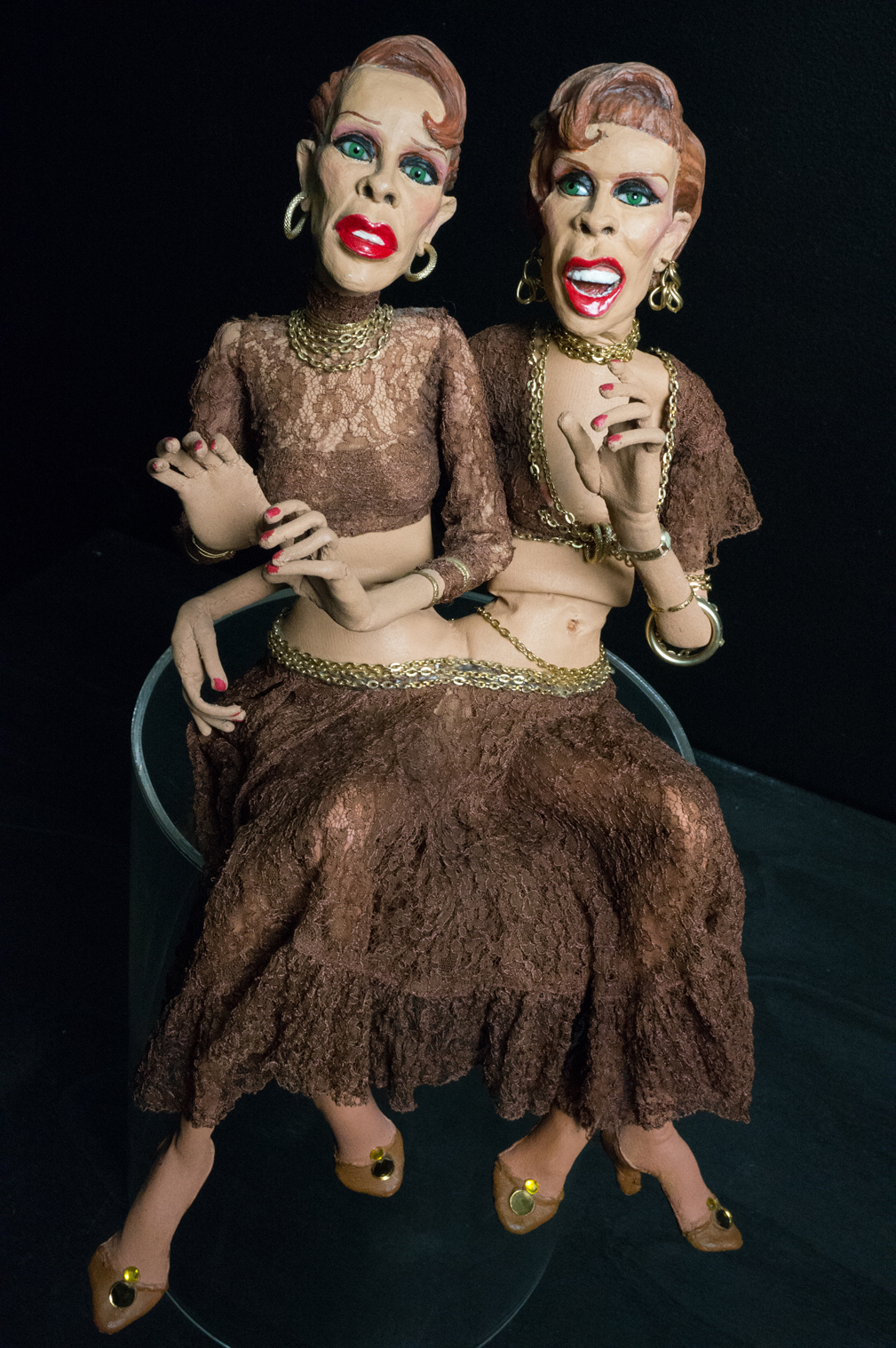
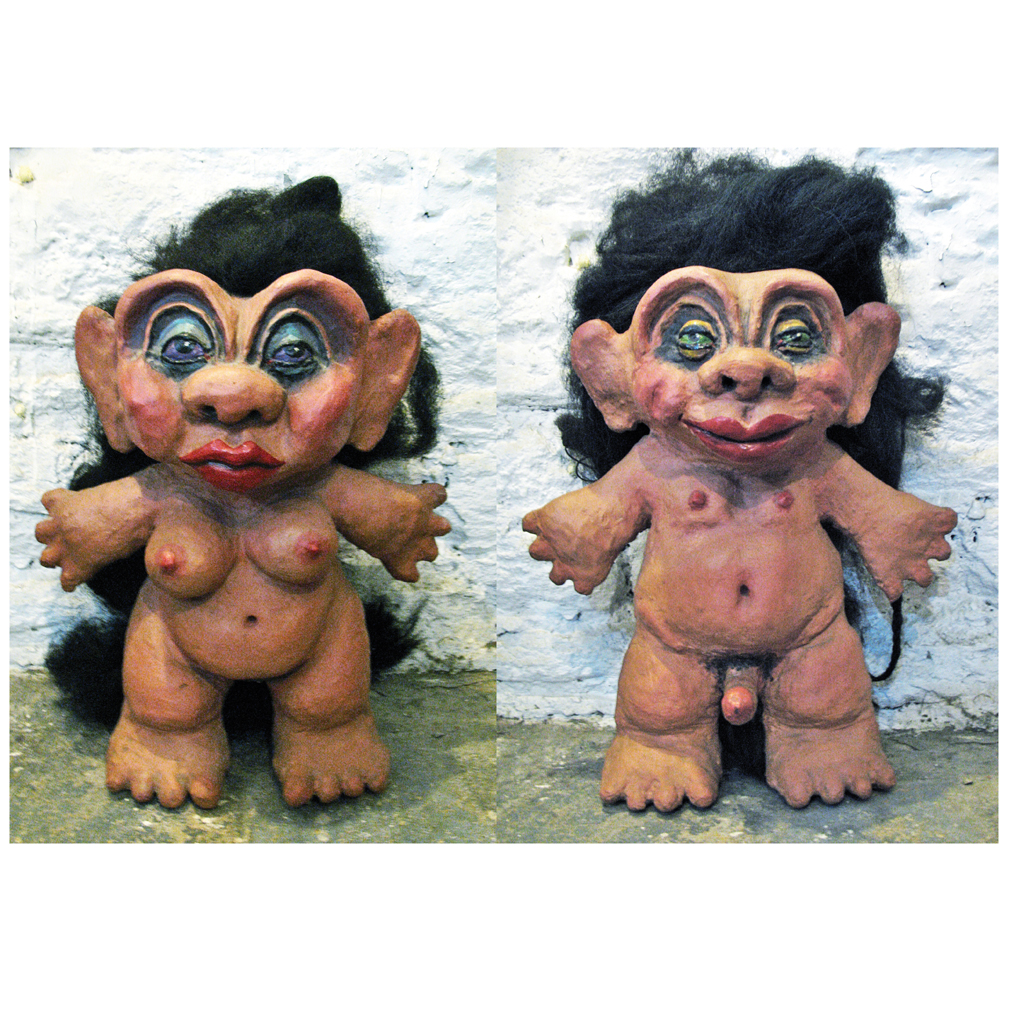
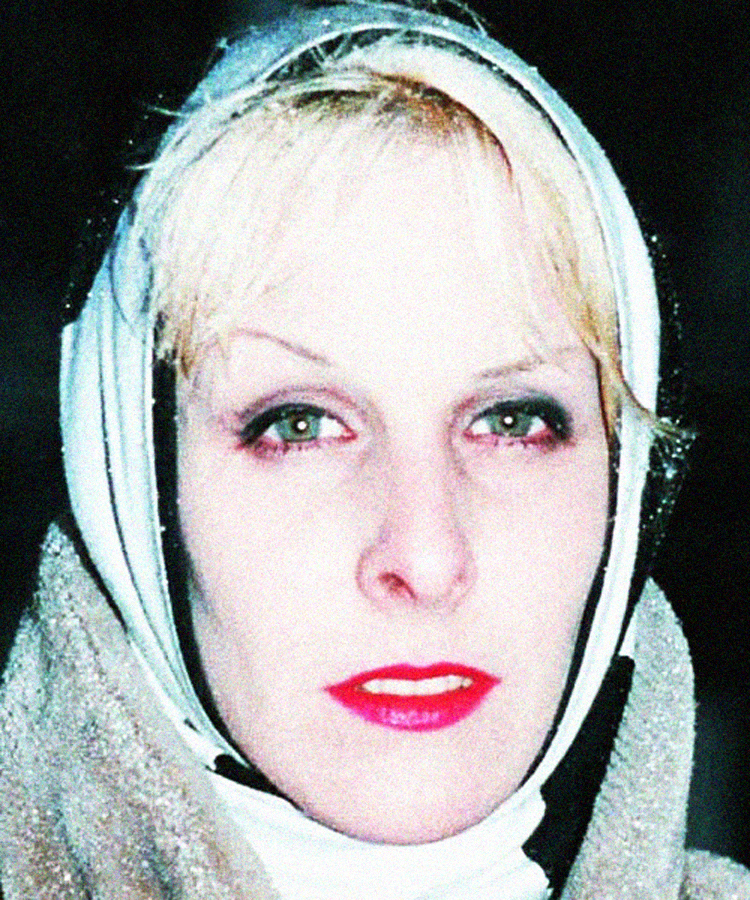
New York’s East Village was a much smaller world in the ’80s, and Greer Lankton was at its center. Showing at neighborhood art galleries and store windows, her signature sewn dolls are part of her marvelous oeuvre, which also includes collage, installation, film, and photography. She was a striking beauty, who performed regularly at the Pyramid Club and modeled for local designers and photographers. Her presence was distinct, and her work was, and is, full of uniquely chaotic whimsy.
Born in Flint, Michigan, Lankton started making dolls at age six. Growing up, she saw herself in trans and drag legends like Candy Darling and Holly Woodlawn, and moved to the city that never sleeps to study at Pratt (following a stint at the Art Institute of Chicago). With a giggling light-hearted humor, she relished camp and pop culture, obsessively tearing through tabloids, amused by alien conspiracy theories and the antics of celebrity life. Her dolls bear extraordinary detail, made from a variety of materials: fabric, paint, metal armatures, human hair, and blown glass eyes. A selection of it-girls and matriarchs served as the muses for her creations; she rendered some of the most potent stars of counter-culture like Little Edie, Peggy Moffitt, and Divine, but also those at the center of society, Diana Vreeland and Jackie Kennedy. And she invented her own characters too — conjoined twins, trolls, contortionists — fully formed personalities and telling stories with their eyes. Her figurative work stretched the potential of caricature’s exaggeration, of its comedic absurdism but also its capacity to tell a story.
In 1987 Lankton married Paul Monroe, who recalls the ceremony: “Peter Hujar was my best man. Teri Toye was Greer’s maid of honor, and Nan Goldin captured it all.” The two were inseparable. Monroe owned EINSTEINS, a boutique in the East Village where he famously sold men’s dresses and as the New York Times reported in 1985, “jewelry incorporating miniature pianos, candelabra, teapots, gondolas and such.” The shop’s front window became one of Lankton’s showplaces, and after the gallery Civilian Warfare closed, she established THE DOLL CLUB inside EINSTEINS, a venue for her cast of oddballs and luminaries, the fiercely beautiful and stupendously grotesque. Her husband is dedicated to preserving her legacy to this day, having founded GLAM, the Greer Lankton Archives Museum, to conserve her work and ephemera from their life, both together and apart.
Along with Lankton’s quirkiness and irreverence, came a story of trauma and addiction. She passed away in 1996, a few short weeks after debuting an impressive installation at the Mattress Factory in Pittsburgh. No one tells Lankton’s story better than she does, as evidenced by the artist statement for her final show:
I’ve been in therapy since 18 months old, started drugs at 12 was diagnosed as schizophrenic at 19, started hormones the week after I quit Thorazine got my dick inverted at 21, kicked Heroin 6 years ago. Have been Anorexic since 19 and plan to continue and you know what I say FUCK Recovery, FUCK PSYCHIATRY Fuck it all because I’m over it. Over the roof. I’m so sick I’m dead, so from now on I take no responsibility for my actions. Oh and I was fucked up the ass by my grandfather since age 5, been brutally raped twice and have had almost every major organ in my body fail at some point. Life support is no picnic for Rhoda so don’t EVEN take me there. By the way I’m an artist and Andy Warhol was the dullest person I ever met in my life. But he’s got a museum so what do I know. Hans Bellmer is my favorite artist.
Love always,
Greer
All images courtesy of the Greer Lankton Archives Museum, L.A.
Greer’s portrait by Paul Monroe, 1987.
This story was printed in GAYLETTER Issue 12, get a copy here.
New York’s East Village was a much smaller world in the ’80s, and Greer Lankton was at its center. Showing at neighborhood art galleries and store windows, her signature sewn dolls are part of her marvelous oeuvre, which also includes collage, installation, film, and photography. She was a striking beauty, who performed regularly at the Pyramid Club and modeled for local designers and photographers. Her presence was distinct, and her work was, and is, full of uniquely chaotic whimsy.
Born in Flint, Michigan, Lankton started making dolls at age six. Growing up, she saw herself in trans and drag legends like Candy Darling and Holly Woodlawn, and moved to the city that never sleeps to study at Pratt (following a stint at the Art Institute of Chicago). With a giggling light-hearted humor, she relished camp and pop culture, obsessively tearing through tabloids, amused by alien conspiracy theories and the antics of celebrity life. Her dolls bear extraordinary detail, made from a variety of materials: fabric, paint, metal armatures, human hair, and blown glass eyes. A selection of it-girls and matriarchs served as the muses for her creations; she rendered some of the most potent stars of counter-culture like Little Edie, Peggy Moffitt, and Divine, but also those at the center of society, Diana Vreeland and Jackie Kennedy. And she invented her own characters too — conjoined twins, trolls, contortionists — fully formed personalities and telling stories with their eyes. Her figurative work stretched the potential of caricature’s exaggeration, of its comedic absurdism but also its capacity to tell a story.
In 1987 Lankton married Paul Monroe, who recalls the ceremony: “Peter Hujar was my best man. Teri Toye was Greer’s maid of honor, and Nan Goldin captured it all.” The two were inseparable. Monroe owned EINSTEINS, a boutique in the East Village where he famously sold men’s dresses and as the New York Times reported in 1985, “jewelry incorporating miniature pianos, candelabra, teapots, gondolas and such.” The shop’s front window became one of Lankton’s showplaces, and after the gallery Civilian Warfare closed, she established THE DOLL CLUB inside EINSTEINS, a venue for her cast of oddballs and luminaries, the fiercely beautiful and stupendously grotesque. Her husband is dedicated to preserving her legacy to this day, having founded GLAM, the Greer Lankton Archives Museum, to conserve her work and ephemera from their life, both together and apart.
Along with Lankton’s quirkiness and irreverence, came a story of trauma and addiction. She passed away in 1996, a few short weeks after debuting an impressive installation at the Mattress Factory in Pittsburgh. No one tells Lankton’s story better than she does, as evidenced by the artist statement for her final show:
I’ve been in therapy since 18 months old, started drugs at 12 was diagnosed as schizophrenic at 19, started hormones the week after I quit Thorazine got my dick inverted at 21, kicked Heroin 6 years ago. Have been Anorexic since 19 and plan to continue and you know what I say FUCK Recovery, FUCK PSYCHIATRY Fuck it all because I’m over it. Over the roof. I’m so sick I’m dead, so from now on I take no responsibility for my actions. Oh and I was fucked up the ass by my grandfather since age 5, been brutally raped twice and have had almost every major organ in my body fail at some point. Life support is no picnic for Rhoda so don’t EVEN take me there. By the way I’m an artist and Andy Warhol was the dullest person I ever met in my life. But he’s got a museum so what do I know. Hans Bellmer is my favorite artist.
Love always,
Greer
All images courtesy of the Greer Lankton Archives Museum, L.A.
Greer’s portrait by Paul Monroe, 1987.
This story was printed in GAYLETTER Issue 12, get a copy here.
New York’s East Village was a much smaller world in the ’80s, and Greer Lankton was at its center. Showing at neighborhood art galleries and store windows, her signature sewn dolls are part of her marvelous oeuvre, which also includes collage, installation, film, and photography. She was a striking beauty, who performed regularly at the Pyramid Club and modeled for local designers and photographers. Her presence was distinct, and her work was, and is, full of uniquely chaotic whimsy.
Born in Flint, Michigan, Lankton started making dolls at age six. Growing up, she saw herself in trans and drag legends like Candy Darling and Holly Woodlawn, and moved to the city that never sleeps to study at Pratt (following a stint at the Art Institute of Chicago). With a giggling light-hearted humor, she relished camp and pop culture, obsessively tearing through tabloids, amused by alien conspiracy theories and the antics of celebrity life. Her dolls bear extraordinary detail, made from a variety of materials: fabric, paint, metal armatures, human hair, and blown glass eyes. A selection of it-girls and matriarchs served as the muses for her creations; she rendered some of the most potent stars of counter-culture like Little Edie, Peggy Moffitt, and Divine, but also those at the center of society, Diana Vreeland and Jackie Kennedy. And she invented her own characters too — conjoined twins, trolls, contortionists — fully formed personalities and telling stories with their eyes. Her figurative work stretched the potential of caricature’s exaggeration, of its comedic absurdism but also its capacity to tell a story.
In 1987 Lankton married Paul Monroe, who recalls the ceremony: “Peter Hujar was my best man. Teri Toye was Greer’s maid of honor, and Nan Goldin captured it all.” The two were inseparable. Monroe owned EINSTEINS, a boutique in the East Village where he famously sold men’s dresses and as the New York Times reported in 1985, “jewelry incorporating miniature pianos, candelabra, teapots, gondolas and such.” The shop’s front window became one of Lankton’s showplaces, and after the gallery Civilian Warfare closed, she established THE DOLL CLUB inside EINSTEINS, a venue for her cast of oddballs and luminaries, the fiercely beautiful and stupendously grotesque. Her husband is dedicated to preserving her legacy to this day, having founded GLAM, the Greer Lankton Archives Museum, to conserve her work and ephemera from their life, both together and apart.
Along with Lankton’s quirkiness and irreverence, came a story of trauma and addiction. She passed away in 1996, a few short weeks after debuting an impressive installation at the Mattress Factory in Pittsburgh. No one tells Lankton’s story better than she does, as evidenced by the artist statement for her final show:
I’ve been in therapy since 18 months old, started drugs at 12 was diagnosed as schizophrenic at 19, started hormones the week after I quit Thorazine got my dick inverted at 21, kicked Heroin 6 years ago. Have been Anorexic since 19 and plan to continue and you know what I say FUCK Recovery, FUCK PSYCHIATRY Fuck it all because I’m over it. Over the roof. I’m so sick I’m dead, so from now on I take no responsibility for my actions. Oh and I was fucked up the ass by my grandfather since age 5, been brutally raped twice and have had almost every major organ in my body fail at some point. Life support is no picnic for Rhoda so don’t EVEN take me there. By the way I’m an artist and Andy Warhol was the dullest person I ever met in my life. But he’s got a museum so what do I know. Hans Bellmer is my favorite artist.
Love always,
Greer
All images courtesy of the Greer Lankton Archives Museum, L.A.
Greer’s portrait by Paul Monroe, 1987.
This story was printed in GAYLETTER Issue 12, get a copy here.
New York’s East Village was a much smaller world in the ’80s, and Greer Lankton was at its center. Showing at neighborhood art galleries and store windows, her signature sewn dolls are part of her marvelous oeuvre, which also includes collage, installation, film, and photography. She was a striking beauty, who performed regularly at the Pyramid Club and modeled for local designers and photographers. Her presence was distinct, and her work was, and is, full of uniquely chaotic whimsy.
Born in Flint, Michigan, Lankton started making dolls at age six. Growing up, she saw herself in trans and drag legends like Candy Darling and Holly Woodlawn, and moved to the city that never sleeps to study at Pratt (following a stint at the Art Institute of Chicago). With a giggling light-hearted humor, she relished camp and pop culture, obsessively tearing through tabloids, amused by alien conspiracy theories and the antics of celebrity life. Her dolls bear extraordinary detail, made from a variety of materials: fabric, paint, metal armatures, human hair, and blown glass eyes. A selection of it-girls and matriarchs served as the muses for her creations; she rendered some of the most potent stars of counter-culture like Little Edie, Peggy Moffitt, and Divine, but also those at the center of society, Diana Vreeland and Jackie Kennedy. And she invented her own characters too — conjoined twins, trolls, contortionists — fully formed personalities and telling stories with their eyes. Her figurative work stretched the potential of caricature’s exaggeration, of its comedic absurdism but also its capacity to tell a story.
In 1987 Lankton married Paul Monroe, who recalls the ceremony: “Peter Hujar was my best man. Teri Toye was Greer’s maid of honor, and Nan Goldin captured it all.” The two were inseparable. Monroe owned EINSTEINS, a boutique in the East Village where he famously sold men’s dresses and as the New York Times reported in 1985, “jewelry incorporating miniature pianos, candelabra, teapots, gondolas and such.” The shop’s front window became one of Lankton’s showplaces, and after the gallery Civilian Warfare closed, she established THE DOLL CLUB inside EINSTEINS, a venue for her cast of oddballs and luminaries, the fiercely beautiful and stupendously grotesque. Her husband is dedicated to preserving her legacy to this day, having founded GLAM, the Greer Lankton Archives Museum, to conserve her work and ephemera from their life, both together and apart.
Along with Lankton’s quirkiness and irreverence, came a story of trauma and addiction. She passed away in 1996, a few short weeks after debuting an impressive installation at the Mattress Factory in Pittsburgh. No one tells Lankton’s story better than she does, as evidenced by the artist statement for her final show:
I’ve been in therapy since 18 months old, started drugs at 12 was diagnosed as schizophrenic at 19, started hormones the week after I quit Thorazine got my dick inverted at 21, kicked Heroin 6 years ago. Have been Anorexic since 19 and plan to continue and you know what I say FUCK Recovery, FUCK PSYCHIATRY Fuck it all because I’m over it. Over the roof. I’m so sick I’m dead, so from now on I take no responsibility for my actions. Oh and I was fucked up the ass by my grandfather since age 5, been brutally raped twice and have had almost every major organ in my body fail at some point. Life support is no picnic for Rhoda so don’t EVEN take me there. By the way I’m an artist and Andy Warhol was the dullest person I ever met in my life. But he’s got a museum so what do I know. Hans Bellmer is my favorite artist.
Love always,
Greer
All images courtesy of the Greer Lankton Archives Museum, L.A.
Greer’s portrait by Paul Monroe, 1987.
This story was printed in GAYLETTER Issue 12, get a copy here.
New York’s East Village was a much smaller world in the ’80s, and Greer Lankton was at its center. Showing at neighborhood art galleries and store windows, her signature sewn dolls are part of her marvelous oeuvre, which also includes collage, installation, film, and photography. She was a striking beauty, who performed regularly at the Pyramid Club and modeled for local designers and photographers. Her presence was distinct, and her work was, and is, full of uniquely chaotic whimsy.
Born in Flint, Michigan, Lankton started making dolls at age six. Growing up, she saw herself in trans and drag legends like Candy Darling and Holly Woodlawn, and moved to the city that never sleeps to study at Pratt (following a stint at the Art Institute of Chicago). With a giggling light-hearted humor, she relished camp and pop culture, obsessively tearing through tabloids, amused by alien conspiracy theories and the antics of celebrity life. Her dolls bear extraordinary detail, made from a variety of materials: fabric, paint, metal armatures, human hair, and blown glass eyes. A selection of it-girls and matriarchs served as the muses for her creations; she rendered some of the most potent stars of counter-culture like Little Edie, Peggy Moffitt, and Divine, but also those at the center of society, Diana Vreeland and Jackie Kennedy. And she invented her own characters too — conjoined twins, trolls, contortionists — fully formed personalities and telling stories with their eyes. Her figurative work stretched the potential of caricature’s exaggeration, of its comedic absurdism but also its capacity to tell a story.
In 1987 Lankton married Paul Monroe, who recalls the ceremony: “Peter Hujar was my best man. Teri Toye was Greer’s maid of honor, and Nan Goldin captured it all.” The two were inseparable. Monroe owned EINSTEINS, a boutique in the East Village where he famously sold men’s dresses and as the New York Times reported in 1985, “jewelry incorporating miniature pianos, candelabra, teapots, gondolas and such.” The shop’s front window became one of Lankton’s showplaces, and after the gallery Civilian Warfare closed, she established THE DOLL CLUB inside EINSTEINS, a venue for her cast of oddballs and luminaries, the fiercely beautiful and stupendously grotesque. Her husband is dedicated to preserving her legacy to this day, having founded GLAM, the Greer Lankton Archives Museum, to conserve her work and ephemera from their life, both together and apart.
Along with Lankton’s quirkiness and irreverence, came a story of trauma and addiction. She passed away in 1996, a few short weeks after debuting an impressive installation at the Mattress Factory in Pittsburgh. No one tells Lankton’s story better than she does, as evidenced by the artist statement for her final show:
I’ve been in therapy since 18 months old, started drugs at 12 was diagnosed as schizophrenic at 19, started hormones the week after I quit Thorazine got my dick inverted at 21, kicked Heroin 6 years ago. Have been Anorexic since 19 and plan to continue and you know what I say FUCK Recovery, FUCK PSYCHIATRY Fuck it all because I’m over it. Over the roof. I’m so sick I’m dead, so from now on I take no responsibility for my actions. Oh and I was fucked up the ass by my grandfather since age 5, been brutally raped twice and have had almost every major organ in my body fail at some point. Life support is no picnic for Rhoda so don’t EVEN take me there. By the way I’m an artist and Andy Warhol was the dullest person I ever met in my life. But he’s got a museum so what do I know. Hans Bellmer is my favorite artist.
Love always,
Greer
All images courtesy of the Greer Lankton Archives Museum, L.A.
Greer’s portrait by Paul Monroe, 1987.
This story was printed in GAYLETTER Issue 12, get a copy here.
New York’s East Village was a much smaller world in the ’80s, and Greer Lankton was at its center. Showing at neighborhood art galleries and store windows, her signature sewn dolls are part of her marvelous oeuvre, which also includes collage, installation, film, and photography. She was a striking beauty, who performed regularly at the Pyramid Club and modeled for local designers and photographers. Her presence was distinct, and her work was, and is, full of uniquely chaotic whimsy.
Born in Flint, Michigan, Lankton started making dolls at age six. Growing up, she saw herself in trans and drag legends like Candy Darling and Holly Woodlawn, and moved to the city that never sleeps to study at Pratt (following a stint at the Art Institute of Chicago). With a giggling light-hearted humor, she relished camp and pop culture, obsessively tearing through tabloids, amused by alien conspiracy theories and the antics of celebrity life. Her dolls bear extraordinary detail, made from a variety of materials: fabric, paint, metal armatures, human hair, and blown glass eyes. A selection of it-girls and matriarchs served as the muses for her creations; she rendered some of the most potent stars of counter-culture like Little Edie, Peggy Moffitt, and Divine, but also those at the center of society, Diana Vreeland and Jackie Kennedy. And she invented her own characters too — conjoined twins, trolls, contortionists — fully formed personalities and telling stories with their eyes. Her figurative work stretched the potential of caricature’s exaggeration, of its comedic absurdism but also its capacity to tell a story.
In 1987 Lankton married Paul Monroe, who recalls the ceremony: “Peter Hujar was my best man. Teri Toye was Greer’s maid of honor, and Nan Goldin captured it all.” The two were inseparable. Monroe owned EINSTEINS, a boutique in the East Village where he famously sold men’s dresses and as the New York Times reported in 1985, “jewelry incorporating miniature pianos, candelabra, teapots, gondolas and such.” The shop’s front window became one of Lankton’s showplaces, and after the gallery Civilian Warfare closed, she established THE DOLL CLUB inside EINSTEINS, a venue for her cast of oddballs and luminaries, the fiercely beautiful and stupendously grotesque. Her husband is dedicated to preserving her legacy to this day, having founded GLAM, the Greer Lankton Archives Museum, to conserve her work and ephemera from their life, both together and apart.
Along with Lankton’s quirkiness and irreverence, came a story of trauma and addiction. She passed away in 1996, a few short weeks after debuting an impressive installation at the Mattress Factory in Pittsburgh. No one tells Lankton’s story better than she does, as evidenced by the artist statement for her final show:
I’ve been in therapy since 18 months old, started drugs at 12 was diagnosed as schizophrenic at 19, started hormones the week after I quit Thorazine got my dick inverted at 21, kicked Heroin 6 years ago. Have been Anorexic since 19 and plan to continue and you know what I say FUCK Recovery, FUCK PSYCHIATRY Fuck it all because I’m over it. Over the roof. I’m so sick I’m dead, so from now on I take no responsibility for my actions. Oh and I was fucked up the ass by my grandfather since age 5, been brutally raped twice and have had almost every major organ in my body fail at some point. Life support is no picnic for Rhoda so don’t EVEN take me there. By the way I’m an artist and Andy Warhol was the dullest person I ever met in my life. But he’s got a museum so what do I know. Hans Bellmer is my favorite artist.
Love always,
Greer
All images courtesy of the Greer Lankton Archives Museum, L.A.
Greer’s portrait by Paul Monroe, 1987.
This story was printed in GAYLETTER Issue 12, get a copy here.
New York’s East Village was a much smaller world in the ’80s, and Greer Lankton was at its center. Showing at neighborhood art galleries and store windows, her signature sewn dolls are part of her marvelous oeuvre, which also includes collage, installation, film, and photography. She was a striking beauty, who performed regularly at the Pyramid Club and modeled for local designers and photographers. Her presence was distinct, and her work was, and is, full of uniquely chaotic whimsy.
Born in Flint, Michigan, Lankton started making dolls at age six. Growing up, she saw herself in trans and drag legends like Candy Darling and Holly Woodlawn, and moved to the city that never sleeps to study at Pratt (following a stint at the Art Institute of Chicago). With a giggling light-hearted humor, she relished camp and pop culture, obsessively tearing through tabloids, amused by alien conspiracy theories and the antics of celebrity life. Her dolls bear extraordinary detail, made from a variety of materials: fabric, paint, metal armatures, human hair, and blown glass eyes. A selection of it-girls and matriarchs served as the muses for her creations; she rendered some of the most potent stars of counter-culture like Little Edie, Peggy Moffitt, and Divine, but also those at the center of society, Diana Vreeland and Jackie Kennedy. And she invented her own characters too — conjoined twins, trolls, contortionists — fully formed personalities and telling stories with their eyes. Her figurative work stretched the potential of caricature’s exaggeration, of its comedic absurdism but also its capacity to tell a story.
In 1987 Lankton married Paul Monroe, who recalls the ceremony: “Peter Hujar was my best man. Teri Toye was Greer’s maid of honor, and Nan Goldin captured it all.” The two were inseparable. Monroe owned EINSTEINS, a boutique in the East Village where he famously sold men’s dresses and as the New York Times reported in 1985, “jewelry incorporating miniature pianos, candelabra, teapots, gondolas and such.” The shop’s front window became one of Lankton’s showplaces, and after the gallery Civilian Warfare closed, she established THE DOLL CLUB inside EINSTEINS, a venue for her cast of oddballs and luminaries, the fiercely beautiful and stupendously grotesque. Her husband is dedicated to preserving her legacy to this day, having founded GLAM, the Greer Lankton Archives Museum, to conserve her work and ephemera from their life, both together and apart.
Along with Lankton’s quirkiness and irreverence, came a story of trauma and addiction. She passed away in 1996, a few short weeks after debuting an impressive installation at the Mattress Factory in Pittsburgh. No one tells Lankton’s story better than she does, as evidenced by the artist statement for her final show:
I’ve been in therapy since 18 months old, started drugs at 12 was diagnosed as schizophrenic at 19, started hormones the week after I quit Thorazine got my dick inverted at 21, kicked Heroin 6 years ago. Have been Anorexic since 19 and plan to continue and you know what I say FUCK Recovery, FUCK PSYCHIATRY Fuck it all because I’m over it. Over the roof. I’m so sick I’m dead, so from now on I take no responsibility for my actions. Oh and I was fucked up the ass by my grandfather since age 5, been brutally raped twice and have had almost every major organ in my body fail at some point. Life support is no picnic for Rhoda so don’t EVEN take me there. By the way I’m an artist and Andy Warhol was the dullest person I ever met in my life. But he’s got a museum so what do I know. Hans Bellmer is my favorite artist.
Love always,
Greer
All images courtesy of the Greer Lankton Archives Museum, L.A.
Greer’s portrait by Paul Monroe, 1987.
This story was printed in GAYLETTER Issue 12, get a copy here.
New York’s East Village was a much smaller world in the ’80s, and Greer Lankton was at its center. Showing at neighborhood art galleries and store windows, her signature sewn dolls are part of her marvelous oeuvre, which also includes collage, installation, film, and photography. She was a striking beauty, who performed regularly at the Pyramid Club and modeled for local designers and photographers. Her presence was distinct, and her work was, and is, full of uniquely chaotic whimsy.
Born in Flint, Michigan, Lankton started making dolls at age six. Growing up, she saw herself in trans and drag legends like Candy Darling and Holly Woodlawn, and moved to the city that never sleeps to study at Pratt (following a stint at the Art Institute of Chicago). With a giggling light-hearted humor, she relished camp and pop culture, obsessively tearing through tabloids, amused by alien conspiracy theories and the antics of celebrity life. Her dolls bear extraordinary detail, made from a variety of materials: fabric, paint, metal armatures, human hair, and blown glass eyes. A selection of it-girls and matriarchs served as the muses for her creations; she rendered some of the most potent stars of counter-culture like Little Edie, Peggy Moffitt, and Divine, but also those at the center of society, Diana Vreeland and Jackie Kennedy. And she invented her own characters too — conjoined twins, trolls, contortionists — fully formed personalities and telling stories with their eyes. Her figurative work stretched the potential of caricature’s exaggeration, of its comedic absurdism but also its capacity to tell a story.
In 1987 Lankton married Paul Monroe, who recalls the ceremony: “Peter Hujar was my best man. Teri Toye was Greer’s maid of honor, and Nan Goldin captured it all.” The two were inseparable. Monroe owned EINSTEINS, a boutique in the East Village where he famously sold men’s dresses and as the New York Times reported in 1985, “jewelry incorporating miniature pianos, candelabra, teapots, gondolas and such.” The shop’s front window became one of Lankton’s showplaces, and after the gallery Civilian Warfare closed, she established THE DOLL CLUB inside EINSTEINS, a venue for her cast of oddballs and luminaries, the fiercely beautiful and stupendously grotesque. Her husband is dedicated to preserving her legacy to this day, having founded GLAM, the Greer Lankton Archives Museum, to conserve her work and ephemera from their life, both together and apart.
Along with Lankton’s quirkiness and irreverence, came a story of trauma and addiction. She passed away in 1996, a few short weeks after debuting an impressive installation at the Mattress Factory in Pittsburgh. No one tells Lankton’s story better than she does, as evidenced by the artist statement for her final show:
I’ve been in therapy since 18 months old, started drugs at 12 was diagnosed as schizophrenic at 19, started hormones the week after I quit Thorazine got my dick inverted at 21, kicked Heroin 6 years ago. Have been Anorexic since 19 and plan to continue and you know what I say FUCK Recovery, FUCK PSYCHIATRY Fuck it all because I’m over it. Over the roof. I’m so sick I’m dead, so from now on I take no responsibility for my actions. Oh and I was fucked up the ass by my grandfather since age 5, been brutally raped twice and have had almost every major organ in my body fail at some point. Life support is no picnic for Rhoda so don’t EVEN take me there. By the way I’m an artist and Andy Warhol was the dullest person I ever met in my life. But he’s got a museum so what do I know. Hans Bellmer is my favorite artist.
Love always,
Greer
All images courtesy of the Greer Lankton Archives Museum, L.A.
Greer’s portrait by Paul Monroe, 1987.
This story was printed in GAYLETTER Issue 12, get a copy here.
New York’s East Village was a much smaller world in the ’80s, and Greer Lankton was at its center. Showing at neighborhood art galleries and store windows, her signature sewn dolls are part of her marvelous oeuvre, which also includes collage, installation, film, and photography. She was a striking beauty, who performed regularly at the Pyramid Club and modeled for local designers and photographers. Her presence was distinct, and her work was, and is, full of uniquely chaotic whimsy.
Born in Flint, Michigan, Lankton started making dolls at age six. Growing up, she saw herself in trans and drag legends like Candy Darling and Holly Woodlawn, and moved to the city that never sleeps to study at Pratt (following a stint at the Art Institute of Chicago). With a giggling light-hearted humor, she relished camp and pop culture, obsessively tearing through tabloids, amused by alien conspiracy theories and the antics of celebrity life. Her dolls bear extraordinary detail, made from a variety of materials: fabric, paint, metal armatures, human hair, and blown glass eyes. A selection of it-girls and matriarchs served as the muses for her creations; she rendered some of the most potent stars of counter-culture like Little Edie, Peggy Moffitt, and Divine, but also those at the center of society, Diana Vreeland and Jackie Kennedy. And she invented her own characters too — conjoined twins, trolls, contortionists — fully formed personalities and telling stories with their eyes. Her figurative work stretched the potential of caricature’s exaggeration, of its comedic absurdism but also its capacity to tell a story.
In 1987 Lankton married Paul Monroe, who recalls the ceremony: “Peter Hujar was my best man. Teri Toye was Greer’s maid of honor, and Nan Goldin captured it all.” The two were inseparable. Monroe owned EINSTEINS, a boutique in the East Village where he famously sold men’s dresses and as the New York Times reported in 1985, “jewelry incorporating miniature pianos, candelabra, teapots, gondolas and such.” The shop’s front window became one of Lankton’s showplaces, and after the gallery Civilian Warfare closed, she established THE DOLL CLUB inside EINSTEINS, a venue for her cast of oddballs and luminaries, the fiercely beautiful and stupendously grotesque. Her husband is dedicated to preserving her legacy to this day, having founded GLAM, the Greer Lankton Archives Museum, to conserve her work and ephemera from their life, both together and apart.
Along with Lankton’s quirkiness and irreverence, came a story of trauma and addiction. She passed away in 1996, a few short weeks after debuting an impressive installation at the Mattress Factory in Pittsburgh. No one tells Lankton’s story better than she does, as evidenced by the artist statement for her final show:
I’ve been in therapy since 18 months old, started drugs at 12 was diagnosed as schizophrenic at 19, started hormones the week after I quit Thorazine got my dick inverted at 21, kicked Heroin 6 years ago. Have been Anorexic since 19 and plan to continue and you know what I say FUCK Recovery, FUCK PSYCHIATRY Fuck it all because I’m over it. Over the roof. I’m so sick I’m dead, so from now on I take no responsibility for my actions. Oh and I was fucked up the ass by my grandfather since age 5, been brutally raped twice and have had almost every major organ in my body fail at some point. Life support is no picnic for Rhoda so don’t EVEN take me there. By the way I’m an artist and Andy Warhol was the dullest person I ever met in my life. But he’s got a museum so what do I know. Hans Bellmer is my favorite artist.
Love always,
Greer
All images courtesy of the Greer Lankton Archives Museum, L.A.
Greer’s portrait by Paul Monroe, 1987.
This story was printed in GAYLETTER Issue 12, get a copy here.
New York’s East Village was a much smaller world in the ’80s, and Greer Lankton was at its center. Showing at neighborhood art galleries and store windows, her signature sewn dolls are part of her marvelous oeuvre, which also includes collage, installation, film, and photography. She was a striking beauty, who performed regularly at the Pyramid Club and modeled for local designers and photographers. Her presence was distinct, and her work was, and is, full of uniquely chaotic whimsy.
Born in Flint, Michigan, Lankton started making dolls at age six. Growing up, she saw herself in trans and drag legends like Candy Darling and Holly Woodlawn, and moved to the city that never sleeps to study at Pratt (following a stint at the Art Institute of Chicago). With a giggling light-hearted humor, she relished camp and pop culture, obsessively tearing through tabloids, amused by alien conspiracy theories and the antics of celebrity life. Her dolls bear extraordinary detail, made from a variety of materials: fabric, paint, metal armatures, human hair, and blown glass eyes. A selection of it-girls and matriarchs served as the muses for her creations; she rendered some of the most potent stars of counter-culture like Little Edie, Peggy Moffitt, and Divine, but also those at the center of society, Diana Vreeland and Jackie Kennedy. And she invented her own characters too — conjoined twins, trolls, contortionists — fully formed personalities and telling stories with their eyes. Her figurative work stretched the potential of caricature’s exaggeration, of its comedic absurdism but also its capacity to tell a story.
In 1987 Lankton married Paul Monroe, who recalls the ceremony: “Peter Hujar was my best man. Teri Toye was Greer’s maid of honor, and Nan Goldin captured it all.” The two were inseparable. Monroe owned EINSTEINS, a boutique in the East Village where he famously sold men’s dresses and as the New York Times reported in 1985, “jewelry incorporating miniature pianos, candelabra, teapots, gondolas and such.” The shop’s front window became one of Lankton’s showplaces, and after the gallery Civilian Warfare closed, she established THE DOLL CLUB inside EINSTEINS, a venue for her cast of oddballs and luminaries, the fiercely beautiful and stupendously grotesque. Her husband is dedicated to preserving her legacy to this day, having founded GLAM, the Greer Lankton Archives Museum, to conserve her work and ephemera from their life, both together and apart.
Along with Lankton’s quirkiness and irreverence, came a story of trauma and addiction. She passed away in 1996, a few short weeks after debuting an impressive installation at the Mattress Factory in Pittsburgh. No one tells Lankton’s story better than she does, as evidenced by the artist statement for her final show:
I’ve been in therapy since 18 months old, started drugs at 12 was diagnosed as schizophrenic at 19, started hormones the week after I quit Thorazine got my dick inverted at 21, kicked Heroin 6 years ago. Have been Anorexic since 19 and plan to continue and you know what I say FUCK Recovery, FUCK PSYCHIATRY Fuck it all because I’m over it. Over the roof. I’m so sick I’m dead, so from now on I take no responsibility for my actions. Oh and I was fucked up the ass by my grandfather since age 5, been brutally raped twice and have had almost every major organ in my body fail at some point. Life support is no picnic for Rhoda so don’t EVEN take me there. By the way I’m an artist and Andy Warhol was the dullest person I ever met in my life. But he’s got a museum so what do I know. Hans Bellmer is my favorite artist.
Love always,
Greer
All images courtesy of the Greer Lankton Archives Museum, L.A.
Greer’s portrait by Paul Monroe, 1987.
This story was printed in GAYLETTER Issue 12, get a copy here.
New York’s East Village was a much smaller world in the ’80s, and Greer Lankton was at its center. Showing at neighborhood art galleries and store windows, her signature sewn dolls are part of her marvelous oeuvre, which also includes collage, installation, film, and photography. She was a striking beauty, who performed regularly at the Pyramid Club and modeled for local designers and photographers. Her presence was distinct, and her work was, and is, full of uniquely chaotic whimsy.
Born in Flint, Michigan, Lankton started making dolls at age six. Growing up, she saw herself in trans and drag legends like Candy Darling and Holly Woodlawn, and moved to the city that never sleeps to study at Pratt (following a stint at the Art Institute of Chicago). With a giggling light-hearted humor, she relished camp and pop culture, obsessively tearing through tabloids, amused by alien conspiracy theories and the antics of celebrity life. Her dolls bear extraordinary detail, made from a variety of materials: fabric, paint, metal armatures, human hair, and blown glass eyes. A selection of it-girls and matriarchs served as the muses for her creations; she rendered some of the most potent stars of counter-culture like Little Edie, Peggy Moffitt, and Divine, but also those at the center of society, Diana Vreeland and Jackie Kennedy. And she invented her own characters too — conjoined twins, trolls, contortionists — fully formed personalities and telling stories with their eyes. Her figurative work stretched the potential of caricature’s exaggeration, of its comedic absurdism but also its capacity to tell a story.
In 1987 Lankton married Paul Monroe, who recalls the ceremony: “Peter Hujar was my best man. Teri Toye was Greer’s maid of honor, and Nan Goldin captured it all.” The two were inseparable. Monroe owned EINSTEINS, a boutique in the East Village where he famously sold men’s dresses and as the New York Times reported in 1985, “jewelry incorporating miniature pianos, candelabra, teapots, gondolas and such.” The shop’s front window became one of Lankton’s showplaces, and after the gallery Civilian Warfare closed, she established THE DOLL CLUB inside EINSTEINS, a venue for her cast of oddballs and luminaries, the fiercely beautiful and stupendously grotesque. Her husband is dedicated to preserving her legacy to this day, having founded GLAM, the Greer Lankton Archives Museum, to conserve her work and ephemera from their life, both together and apart.
Along with Lankton’s quirkiness and irreverence, came a story of trauma and addiction. She passed away in 1996, a few short weeks after debuting an impressive installation at the Mattress Factory in Pittsburgh. No one tells Lankton’s story better than she does, as evidenced by the artist statement for her final show:
I’ve been in therapy since 18 months old, started drugs at 12 was diagnosed as schizophrenic at 19, started hormones the week after I quit Thorazine got my dick inverted at 21, kicked Heroin 6 years ago. Have been Anorexic since 19 and plan to continue and you know what I say FUCK Recovery, FUCK PSYCHIATRY Fuck it all because I’m over it. Over the roof. I’m so sick I’m dead, so from now on I take no responsibility for my actions. Oh and I was fucked up the ass by my grandfather since age 5, been brutally raped twice and have had almost every major organ in my body fail at some point. Life support is no picnic for Rhoda so don’t EVEN take me there. By the way I’m an artist and Andy Warhol was the dullest person I ever met in my life. But he’s got a museum so what do I know. Hans Bellmer is my favorite artist.
Love always,
Greer
All images courtesy of the Greer Lankton Archives Museum, L.A.
Greer’s portrait by Paul Monroe, 1987.
This story was printed in GAYLETTER Issue 12, get a copy here.
New York’s East Village was a much smaller world in the ’80s, and Greer Lankton was at its center. Showing at neighborhood art galleries and store windows, her signature sewn dolls are part of her marvelous oeuvre, which also includes collage, installation, film, and photography. She was a striking beauty, who performed regularly at the Pyramid Club and modeled for local designers and photographers. Her presence was distinct, and her work was, and is, full of uniquely chaotic whimsy.
Born in Flint, Michigan, Lankton started making dolls at age six. Growing up, she saw herself in trans and drag legends like Candy Darling and Holly Woodlawn, and moved to the city that never sleeps to study at Pratt (following a stint at the Art Institute of Chicago). With a giggling light-hearted humor, she relished camp and pop culture, obsessively tearing through tabloids, amused by alien conspiracy theories and the antics of celebrity life. Her dolls bear extraordinary detail, made from a variety of materials: fabric, paint, metal armatures, human hair, and blown glass eyes. A selection of it-girls and matriarchs served as the muses for her creations; she rendered some of the most potent stars of counter-culture like Little Edie, Peggy Moffitt, and Divine, but also those at the center of society, Diana Vreeland and Jackie Kennedy. And she invented her own characters too — conjoined twins, trolls, contortionists — fully formed personalities and telling stories with their eyes. Her figurative work stretched the potential of caricature’s exaggeration, of its comedic absurdism but also its capacity to tell a story.
In 1987 Lankton married Paul Monroe, who recalls the ceremony: “Peter Hujar was my best man. Teri Toye was Greer’s maid of honor, and Nan Goldin captured it all.” The two were inseparable. Monroe owned EINSTEINS, a boutique in the East Village where he famously sold men’s dresses and as the New York Times reported in 1985, “jewelry incorporating miniature pianos, candelabra, teapots, gondolas and such.” The shop’s front window became one of Lankton’s showplaces, and after the gallery Civilian Warfare closed, she established THE DOLL CLUB inside EINSTEINS, a venue for her cast of oddballs and luminaries, the fiercely beautiful and stupendously grotesque. Her husband is dedicated to preserving her legacy to this day, having founded GLAM, the Greer Lankton Archives Museum, to conserve her work and ephemera from their life, both together and apart.
Along with Lankton’s quirkiness and irreverence, came a story of trauma and addiction. She passed away in 1996, a few short weeks after debuting an impressive installation at the Mattress Factory in Pittsburgh. No one tells Lankton’s story better than she does, as evidenced by the artist statement for her final show:
I’ve been in therapy since 18 months old, started drugs at 12 was diagnosed as schizophrenic at 19, started hormones the week after I quit Thorazine got my dick inverted at 21, kicked Heroin 6 years ago. Have been Anorexic since 19 and plan to continue and you know what I say FUCK Recovery, FUCK PSYCHIATRY Fuck it all because I’m over it. Over the roof. I’m so sick I’m dead, so from now on I take no responsibility for my actions. Oh and I was fucked up the ass by my grandfather since age 5, been brutally raped twice and have had almost every major organ in my body fail at some point. Life support is no picnic for Rhoda so don’t EVEN take me there. By the way I’m an artist and Andy Warhol was the dullest person I ever met in my life. But he’s got a museum so what do I know. Hans Bellmer is my favorite artist.
Love always,
Greer
All images courtesy of the Greer Lankton Archives Museum, L.A.
Greer’s portrait by Paul Monroe, 1987.
This story was printed in GAYLETTER Issue 12, get a copy here.
New York’s East Village was a much smaller world in the ’80s, and Greer Lankton was at its center. Showing at neighborhood art galleries and store windows, her signature sewn dolls are part of her marvelous oeuvre, which also includes collage, installation, film, and photography. She was a striking beauty, who performed regularly at the Pyramid Club and modeled for local designers and photographers. Her presence was distinct, and her work was, and is, full of uniquely chaotic whimsy.
Born in Flint, Michigan, Lankton started making dolls at age six. Growing up, she saw herself in trans and drag legends like Candy Darling and Holly Woodlawn, and moved to the city that never sleeps to study at Pratt (following a stint at the Art Institute of Chicago). With a giggling light-hearted humor, she relished camp and pop culture, obsessively tearing through tabloids, amused by alien conspiracy theories and the antics of celebrity life. Her dolls bear extraordinary detail, made from a variety of materials: fabric, paint, metal armatures, human hair, and blown glass eyes. A selection of it-girls and matriarchs served as the muses for her creations; she rendered some of the most potent stars of counter-culture like Little Edie, Peggy Moffitt, and Divine, but also those at the center of society, Diana Vreeland and Jackie Kennedy. And she invented her own characters too — conjoined twins, trolls, contortionists — fully formed personalities and telling stories with their eyes. Her figurative work stretched the potential of caricature’s exaggeration, of its comedic absurdism but also its capacity to tell a story.
In 1987 Lankton married Paul Monroe, who recalls the ceremony: “Peter Hujar was my best man. Teri Toye was Greer’s maid of honor, and Nan Goldin captured it all.” The two were inseparable. Monroe owned EINSTEINS, a boutique in the East Village where he famously sold men’s dresses and as the New York Times reported in 1985, “jewelry incorporating miniature pianos, candelabra, teapots, gondolas and such.” The shop’s front window became one of Lankton’s showplaces, and after the gallery Civilian Warfare closed, she established THE DOLL CLUB inside EINSTEINS, a venue for her cast of oddballs and luminaries, the fiercely beautiful and stupendously grotesque. Her husband is dedicated to preserving her legacy to this day, having founded GLAM, the Greer Lankton Archives Museum, to conserve her work and ephemera from their life, both together and apart.
Along with Lankton’s quirkiness and irreverence, came a story of trauma and addiction. She passed away in 1996, a few short weeks after debuting an impressive installation at the Mattress Factory in Pittsburgh. No one tells Lankton’s story better than she does, as evidenced by the artist statement for her final show:
I’ve been in therapy since 18 months old, started drugs at 12 was diagnosed as schizophrenic at 19, started hormones the week after I quit Thorazine got my dick inverted at 21, kicked Heroin 6 years ago. Have been Anorexic since 19 and plan to continue and you know what I say FUCK Recovery, FUCK PSYCHIATRY Fuck it all because I’m over it. Over the roof. I’m so sick I’m dead, so from now on I take no responsibility for my actions. Oh and I was fucked up the ass by my grandfather since age 5, been brutally raped twice and have had almost every major organ in my body fail at some point. Life support is no picnic for Rhoda so don’t EVEN take me there. By the way I’m an artist and Andy Warhol was the dullest person I ever met in my life. But he’s got a museum so what do I know. Hans Bellmer is my favorite artist.
Love always,
Greer
All images courtesy of the Greer Lankton Archives Museum, L.A.
Greer’s portrait by Paul Monroe, 1987.
This story was printed in GAYLETTER Issue 12, get a copy here.
New York’s East Village was a much smaller world in the ’80s, and Greer Lankton was at its center. Showing at neighborhood art galleries and store windows, her signature sewn dolls are part of her marvelous oeuvre, which also includes collage, installation, film, and photography. She was a striking beauty, who performed regularly at the Pyramid Club and modeled for local designers and photographers. Her presence was distinct, and her work was, and is, full of uniquely chaotic whimsy.
Born in Flint, Michigan, Lankton started making dolls at age six. Growing up, she saw herself in trans and drag legends like Candy Darling and Holly Woodlawn, and moved to the city that never sleeps to study at Pratt (following a stint at the Art Institute of Chicago). With a giggling light-hearted humor, she relished camp and pop culture, obsessively tearing through tabloids, amused by alien conspiracy theories and the antics of celebrity life. Her dolls bear extraordinary detail, made from a variety of materials: fabric, paint, metal armatures, human hair, and blown glass eyes. A selection of it-girls and matriarchs served as the muses for her creations; she rendered some of the most potent stars of counter-culture like Little Edie, Peggy Moffitt, and Divine, but also those at the center of society, Diana Vreeland and Jackie Kennedy. And she invented her own characters too — conjoined twins, trolls, contortionists — fully formed personalities and telling stories with their eyes. Her figurative work stretched the potential of caricature’s exaggeration, of its comedic absurdism but also its capacity to tell a story.
In 1987 Lankton married Paul Monroe, who recalls the ceremony: “Peter Hujar was my best man. Teri Toye was Greer’s maid of honor, and Nan Goldin captured it all.” The two were inseparable. Monroe owned EINSTEINS, a boutique in the East Village where he famously sold men’s dresses and as the New York Times reported in 1985, “jewelry incorporating miniature pianos, candelabra, teapots, gondolas and such.” The shop’s front window became one of Lankton’s showplaces, and after the gallery Civilian Warfare closed, she established THE DOLL CLUB inside EINSTEINS, a venue for her cast of oddballs and luminaries, the fiercely beautiful and stupendously grotesque. Her husband is dedicated to preserving her legacy to this day, having founded GLAM, the Greer Lankton Archives Museum, to conserve her work and ephemera from their life, both together and apart.
Along with Lankton’s quirkiness and irreverence, came a story of trauma and addiction. She passed away in 1996, a few short weeks after debuting an impressive installation at the Mattress Factory in Pittsburgh. No one tells Lankton’s story better than she does, as evidenced by the artist statement for her final show:
I’ve been in therapy since 18 months old, started drugs at 12 was diagnosed as schizophrenic at 19, started hormones the week after I quit Thorazine got my dick inverted at 21, kicked Heroin 6 years ago. Have been Anorexic since 19 and plan to continue and you know what I say FUCK Recovery, FUCK PSYCHIATRY Fuck it all because I’m over it. Over the roof. I’m so sick I’m dead, so from now on I take no responsibility for my actions. Oh and I was fucked up the ass by my grandfather since age 5, been brutally raped twice and have had almost every major organ in my body fail at some point. Life support is no picnic for Rhoda so don’t EVEN take me there. By the way I’m an artist and Andy Warhol was the dullest person I ever met in my life. But he’s got a museum so what do I know. Hans Bellmer is my favorite artist.
Love always,
Greer
All images courtesy of the Greer Lankton Archives Museum, L.A.
Greer’s portrait by Paul Monroe, 1987.
This story was printed in GAYLETTER Issue 12, get a copy here.
1/14